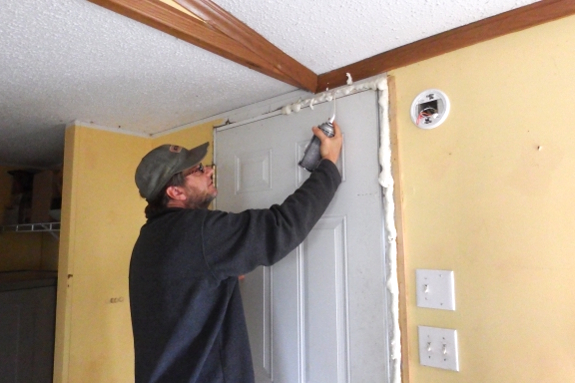
archives for 11/2017
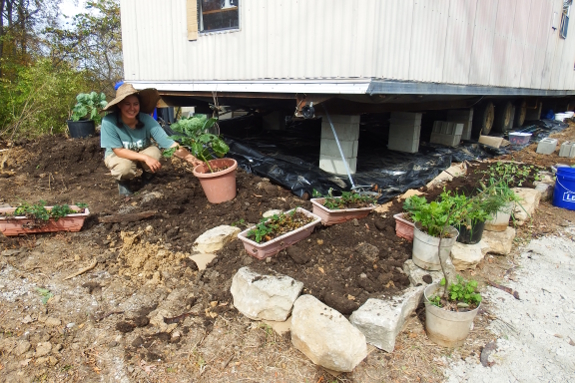
I considered spreading
out my trailer load of manure
to enrich a large area bit by bit. But, instead, I focused on
making a few areas rich and ready to turbo charge our transplants.
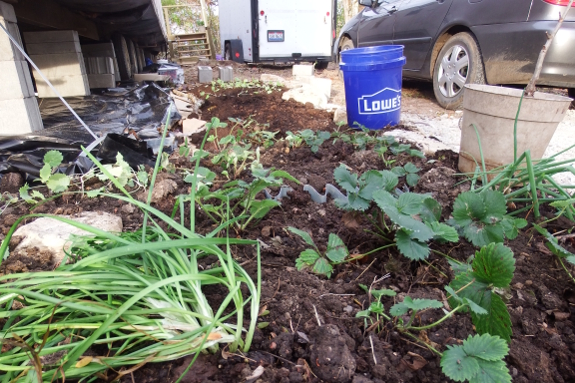
Most of the plants I potted up three
months ago
only hung on rather than thriving. But the garlic chives spread their
roots through a large pot and are now ready to take on the world.
Our first planting
consisted of kale, two varieties of strawberries, Egyptian onions,
garlic chives, brussels sprouts, and direct-seeded lettuce. I kept the
celery and rosemary in pots to be taken in once real cold weather hits.
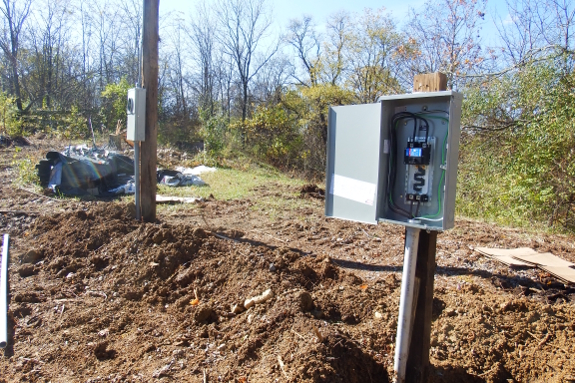

Right.
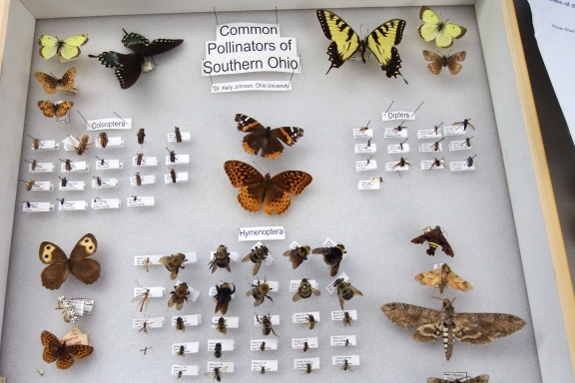
Before moving, I
promised myself I'd attend at least two events per week to make turning
our lives upside down for the sake of greater opportunities worthwhile.
As it turns out, the trick is not putting two events I want to attend
on my planner for every single day.

I haven't been posting
about most of our eye-opening experiences here, but the Bio Bonanza at
the library was photogenic enough that I thought I'd share even though
it's not really homesteading related. Since the insect table was the
least popular, I spent a lot of time learning about species like these
White Witches, the biggest moths in the world!

In case you're curious,
White Witches aren't from around here, and neither are three of the
four butterflies pictured above. (Bonus points if you can pick out the
native species.) But the mixture of species illustrated an interesting
point --- that narrow-winged butterflies and moths spend more energy
flying but can fly faster, while butterflies shaped like the Blue
Morpho on the right are slow but un-needy gliders.
Off to mark another half
dozen potential events on my calendar. Happy belated Halloween!
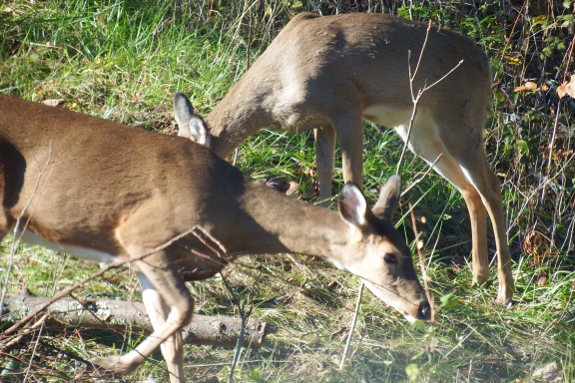
"Do deer
trails mean you will have some fresh venison this year?" --- Eric
There's even a six-point buck hanging out at the borders of our yard.
The neighbors are too close for safe shooting, though. So Anna has hung up her deerslayer rifle.
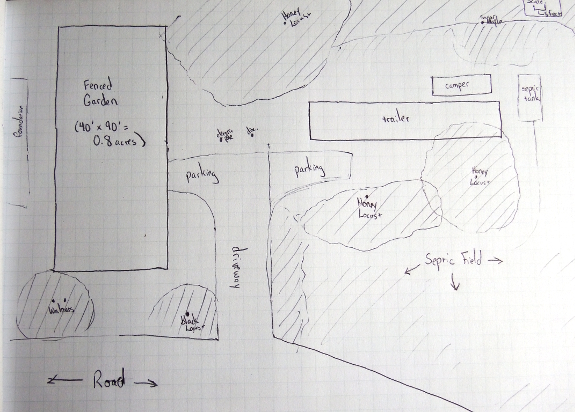
The time has come for
the most exciting part of our move --- our first perennial order! With
eleven years of experience to call upon, it'll be easier to choose the
plants that yield the most with the least expended effort this time
around. But how many of each will fit?
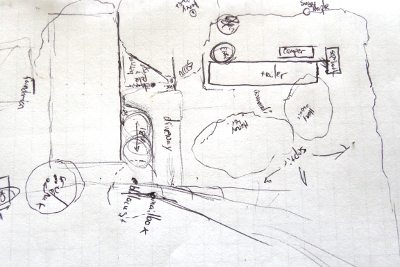 To start with, I used a tape
measurer to plot out the existing structures and shade trees in our
core homestead, beginning at one square for every ten feet. Of course,
once I'd drawn the rough map on the right, I realized I could have made
the scale twice as big. So I replotted a better base map on a new sheet
of graph paper (top image).
To start with, I used a tape
measurer to plot out the existing structures and shade trees in our
core homestead, beginning at one square for every ten feet. Of course,
once I'd drawn the rough map on the right, I realized I could have made
the scale twice as big. So I replotted a better base map on a new sheet
of graph paper (top image).
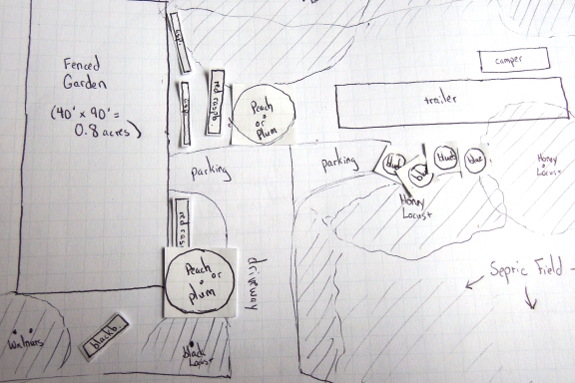
On our previous
homestead, we fenced the whole homestead with a complicated
mixture of systems
that worked...as long as we also had a dog to make the interior
moderately scary to deer. This time around, we haven't yet committed to
a canine companion. So we're planning a deer-proof
fence for the tastiest edibles, then will be putting the less
sensitive plants here and there around the remaining sunny areas.
The image above shows my plan for the less-deer-friendly plants so far.
What do you think --- will the nibblers make me regret putting
raspberries, blackberries, blueberries, asparagus, a peach, and a plum
outside the fence?
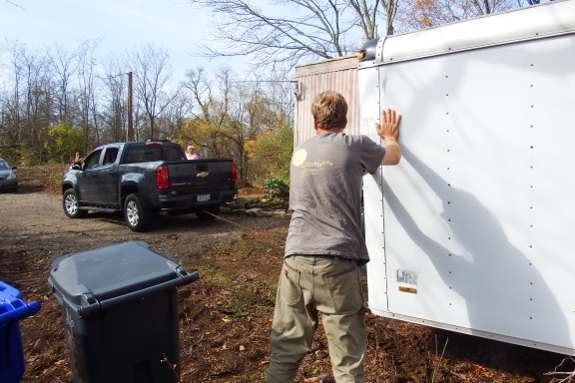
Hook up a chain and pull it with your mom's truck. Just be sure to push on the downhill side so the trailer doesn't roll away.
Great work backing and towing, Jayne!
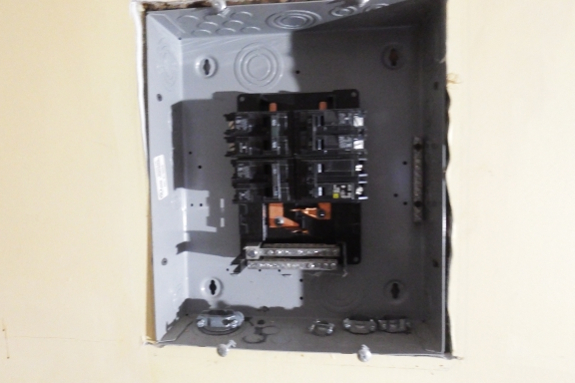
Our trailer came with
some interesting wiring puzzles. First was this empty breaker box in
the living room with absolutely nothing attached to it. Our best guess
is that this was originally wired to an electric stove and furnace
(both of which are absent, including their cords). Since the main
breaker box (like this one) is only wired for 100 amp service,
presumably the previous owners ran a second line in the trailer's
original location and made the trailer 200 amps in a complicated way.
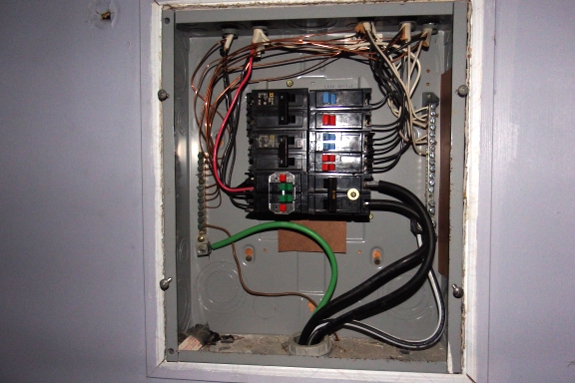
So, the question became
--- can we wire the new items we'll need into the main breaker box or
do we need to follow the previous owners' lead? The first step was
taking a good hard look at the breakers currently in use. On the right
side, from top to bottom, there's a 15 amp breaker, a 20 amp breaker, a
15 amp breaker, a 20 amp breaker, then the main line coming in.
Excepting the last, this side is clearly wired to the sockets in the
walls throughout the house (based on the small amperages and the
similarly small wires).
On the left side, only
the bottom breaker(s) are in use. I say "breaker(s)" because this
appears to be a 20 amp breaker with a 30 amp breaker in the middle, and
I'm assuming the two are attached to the now absent dryer and hot water
heater (respectively). Above that are two unused breakers.
What do we want to put
back in? An electric range (40 or 50 amp breaker), a heat-pump water
heater (30 amp breaker), a gas dryer (15 amp breaker...and a long story
we'll tell you in another post), and a minisplit heat pump (15 amp
breaker). Technically, these will all fit into the box, but will we be
going over the amount of juice a 100-amp service can supply?
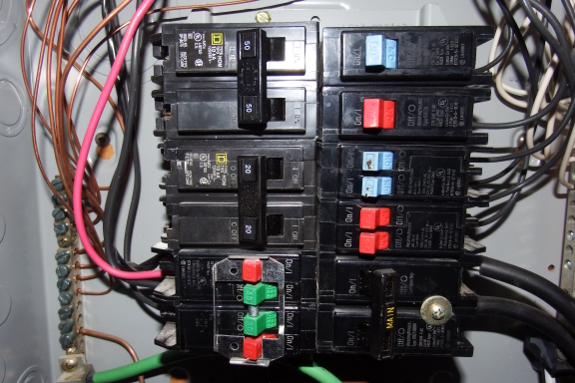
The internet suggests
the rule of thumb is that the total amperage in your breaker box
shouldn't exceed twice the total amperage of your service. So, a
100-amp breaker box can be wired with 200 amps worth of breakers.
Adding up everything we have and want comes to 180 amps. So, unless I'm
missing something, it looks like we're all set to wire in our new
appliances!
(Sorry for the sparse,
shoddy photos. It's a dark day and no electricity means we can't
brighten it up much. We're hoping for juice by the end of the week!)
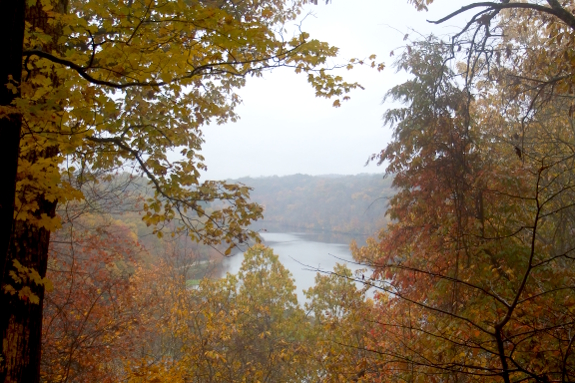
I snuck away last Friday
to try out a hike at Strouds Run State Park, which is located a
whopping twelve minutes away from our new homestead.
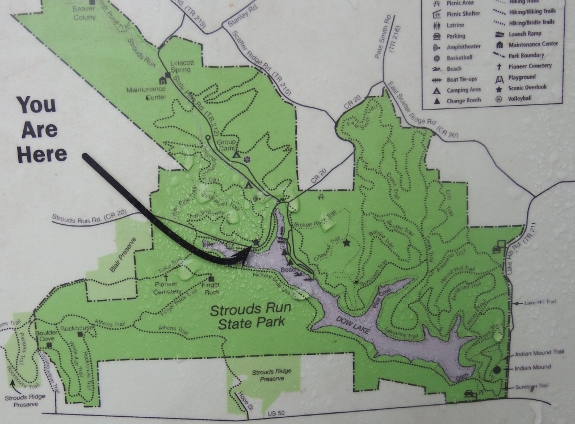
The map I'd downloaded
off the internet didn't give me a very good idea
of distances, so I lucked into a bite-size loop --- Thunderbunny Trail
to Vista Point Trail to White Pine Trail back to Thunderbunny Trail.
I'm guessing the walk was about 1.5 to 2 miles, with one short but
steepish uphill and the rest a gentle stroll through towering white
pines, an oak ridge, and a hillside coated in sugar maples.
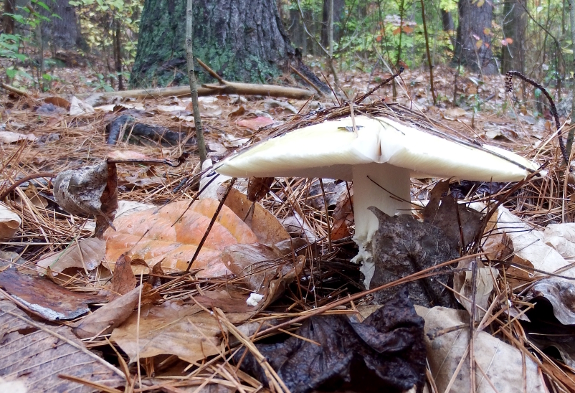
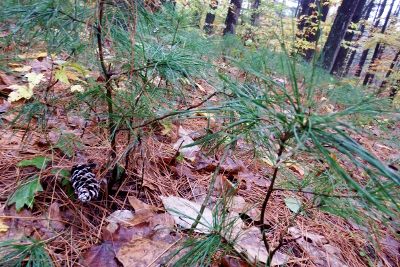 The Thunderbunny portion of
the walk suffered a bit from proximity to the road. But I enjoyed the
location anyway when I found a big patch of yellow-capped mushrooms and
a grove of regenerating white pines to catch my interest.
The Thunderbunny portion of
the walk suffered a bit from proximity to the road. But I enjoyed the
location anyway when I found a big patch of yellow-capped mushrooms and
a grove of regenerating white pines to catch my interest.
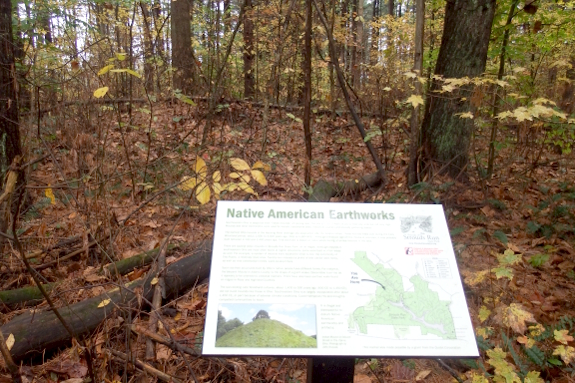
Later, there was a
lovely vista of Dow Lake (shown at the top of this post) and a
fascinating if rather inconspicous Indian Mound.
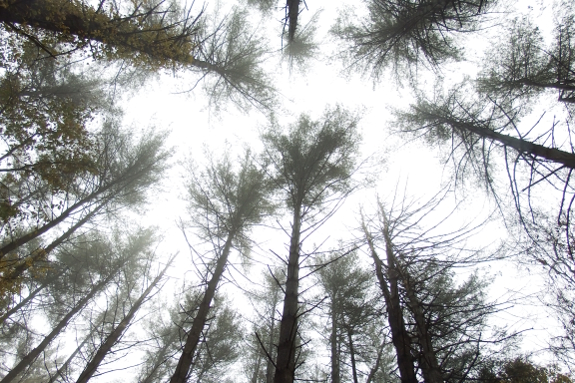
Mostly, though, I just
enjoyed the trees.
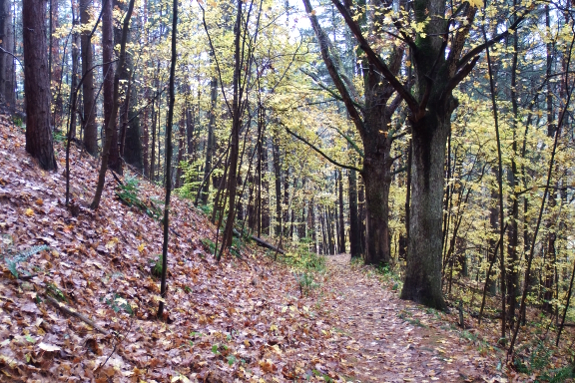
One trail explored. At
least a dozen within a similar distance from our farm left to check out!
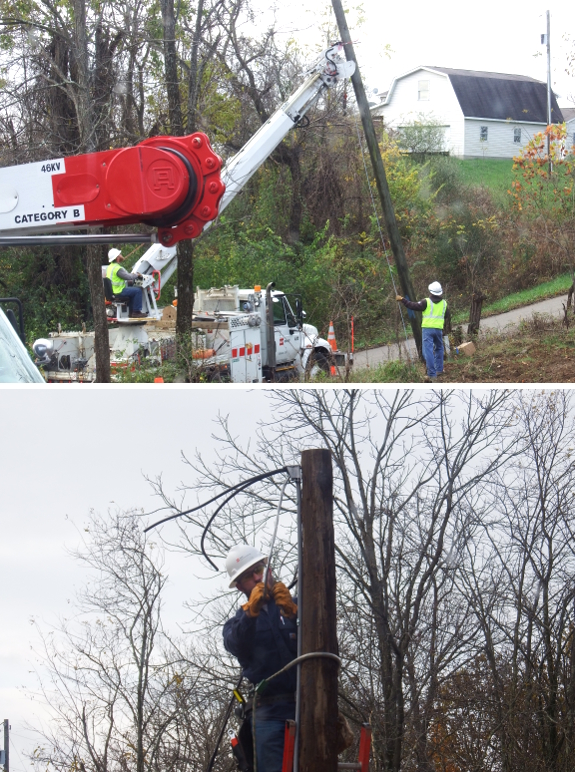

So far, our ridgetop
location seems to be moderating low temperatures as expected. We missed
the October frosts that hit so many other folks, skating by at 35 even
though the projected low was 28 one night. This is in stark contrast to
our previous, north-facing, valley-bottom farm where lows could often
dip as much as ten degrees below the forecast.
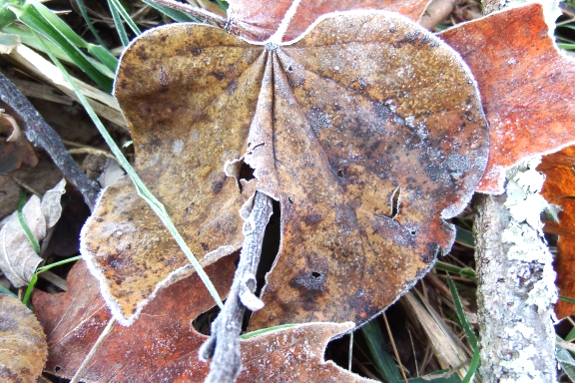
But all gentle autumns
must come to an end. The night after our electricity was turned on, I
woke to frost on the grass. 30 degrees --- enough to send many of the
tree leaves tumbling but not so much it nipped my winter garden. Now to
see if the ridgetop mildness can make up for me planting everything a
month late....
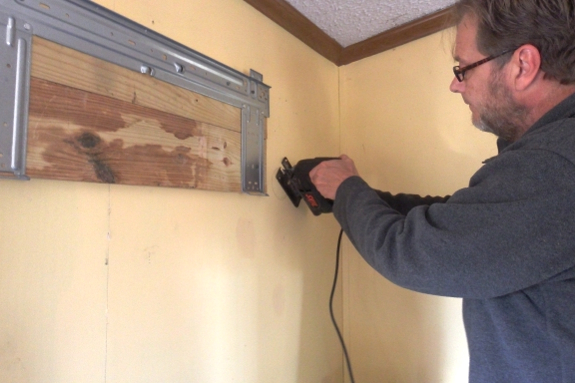
We decided to buy the brand we want anyway and install it ourselves.
Stage one involved mounting the indoor unit. Easy once we figured out our stud spacing. Sixteen inches on center.
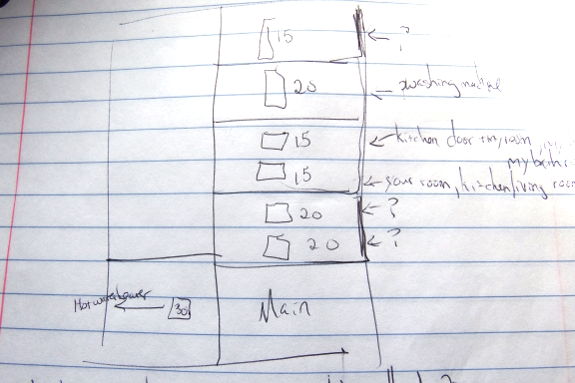
Figuring out our
breaker box became a
lot more intuitive once our electricity was turned on. At that point,
we were able to use the tried-and-true technique of turning on all the
lights in the house then flicking breakers one by one to see when each
zone went dark.
In the process, I
learned that I'd incorrectly added up the amperage already in use in
our box. First of all, there were three wired but apparently unused
breakers in operation. I'm a little leery of simply deleting them, but
I'm equally leery of leaving juice running to wires that seem to go
nowhere. At the moment, I'm leaning toward pulling those mystery
breakers and associated wires out and using the spots for something
else.
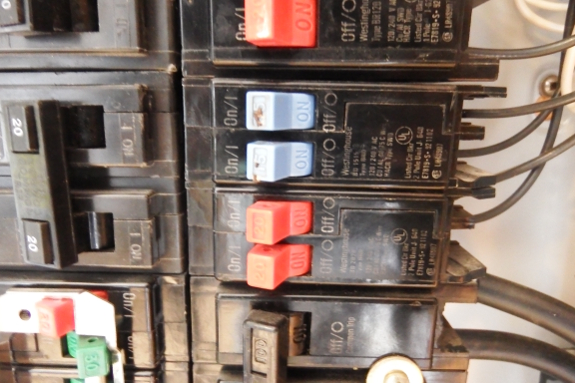
I also learned that the
two breakers shown in the center of the photo above are what's known as
tandem (or cheater) breakers. Each one allows the wiring of two
unrelated circuits in a single spot. Despite the name, they're
not necessarily cheating...although they can be.
Tandem breakers can also be a
problem because they're small and heat up easily, so they have a
tendency to flip a lot. Sure enough, Mark's breaker flicks every time
he turns his space heater and his big monitor on at the same time.
Assuming those confusing slots mentioned above really aren't in
use, it seems like a good idea to ditch the "cheaters" and wire each of
our zones onto a standalone circuit that will be less likely to
overheat.
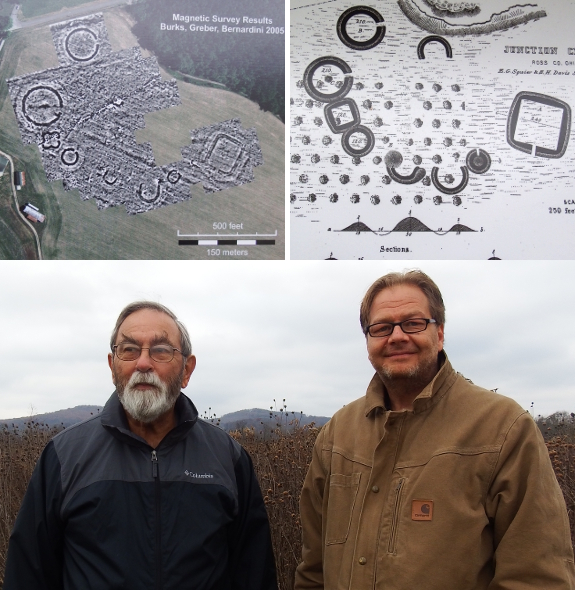
But a road closure made the choice for us.
Actually, both roads were closed, but Errol knew a back road to reach the mound site.
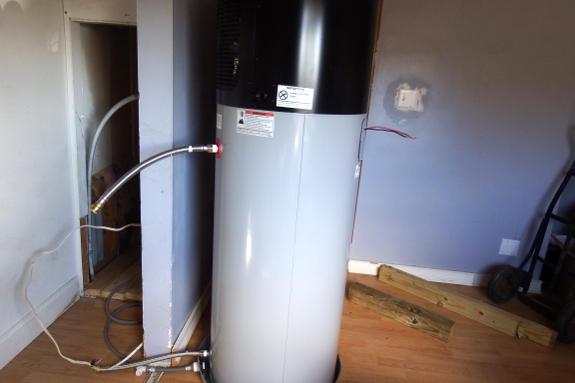
Research suggests that heat-pump water heaters are by far
the most energy-efficient option for most households. They're approximately
three times as efficient as ordinary electric water heaters since they
don't create warmth...they merely move heat out of the air and into the
water.
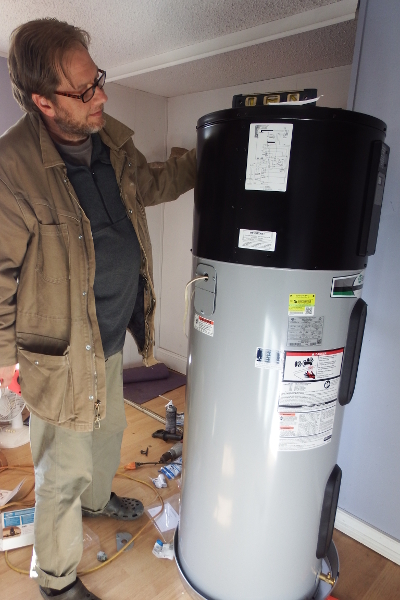 (A gas, point-of-use device at each hot-water faucet approaches the
same efficiency. But we're not on a natural gas line and didn't have to
make that choice. Electric point-of-use hot-water heaters can't come
close to heat-pump technology.)
(A gas, point-of-use device at each hot-water faucet approaches the
same efficiency. But we're not on a natural gas line and didn't have to
make that choice. Electric point-of-use hot-water heaters can't come
close to heat-pump technology.)
Downsides of a heat-pump
water heater include the high initial price tag (but look for rebates!)
and the hum of a fan. Heat-pump water heaters also cool the air around
them (great in summer, not so great in the winter). And they need a
large, open area with a temperature that doesn't drop below 45
Fahrenheit for optimal performance.
I decided to give up a bit of square footage in my writing space for
optimal, energy-efficient hot water. More on what we think of our high-class heater in a later post!
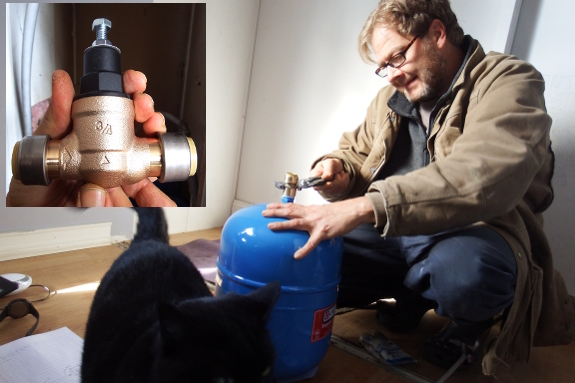
Total elapsed time for the entire project was three hours hands-on plus two hours at Lowes.
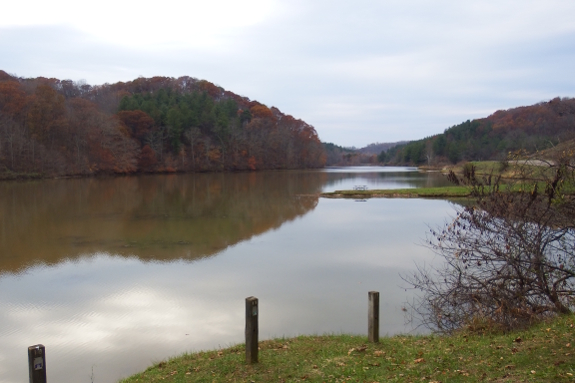
This past weekend, I
discovered that I'd been driving the long way around to get to the
nearby Strouds Run State Park. Taking the shortcut means I hit park
property only 2.1 miles from our house, and in double that distance we
achieve the scenic (if man-made) Dow Lake. Inspired by the close
proximity, I tried out not one new trail this week but two.
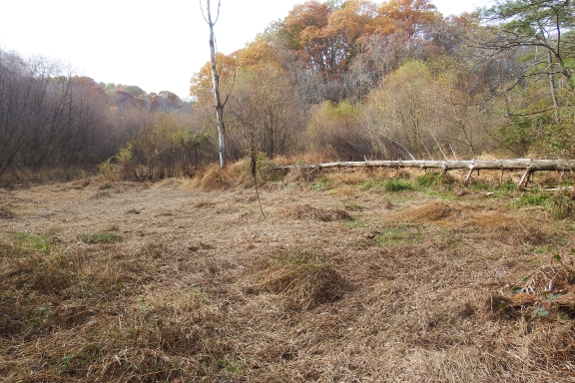
In addition to ambling
along the Lakeview Trail, I also enjoyed Beaver Pond Trail...which ends
in this flat, open area where a pond probably stood only a couple of
years before. The walk was a lesson in impermanence --- how human to
name a trail after something that can disappear based on a whim of the
weather combined with a critter's unpredictable brain. Is this a bit
like giving directions based on "that old store that used to be owned
by the Joneses back in 1977"?
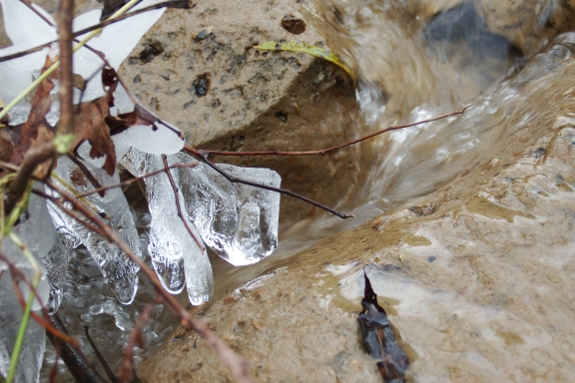
Despite the minor
disappointment of finding no beaver or pond on Beaver Pond Trail, I
thoroughly enjoyed the walk. Because the setting was a broad floodplain
with clay-lined streams exactly like the one we moved away from. Now I
know where to go if I ever get homesick!
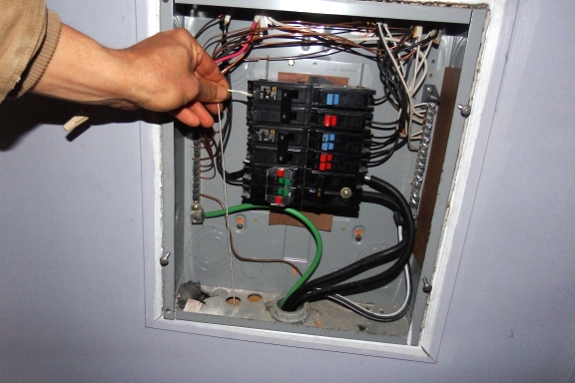
At that price, it's essential to guess your distances correctly.
Running a string from the fuse box to the stove is a good start. Then add 15% for wiggle room.
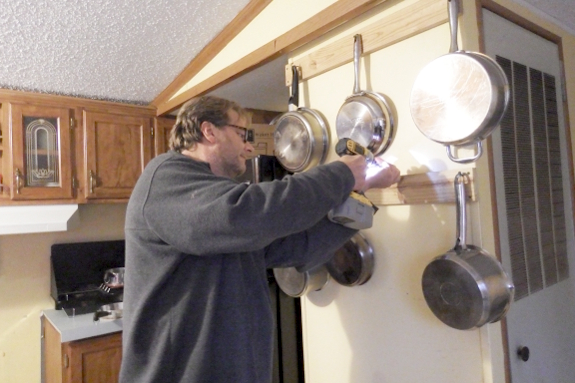
It's amazing how hanging
up pots makes a new kitchen feel like my own. Mark added some thin
boards to give his screws something to bite into between studs,
providing space to hang up the most-used items. (Thanks for yard saling
such great sauce pans, Rose Nell!)
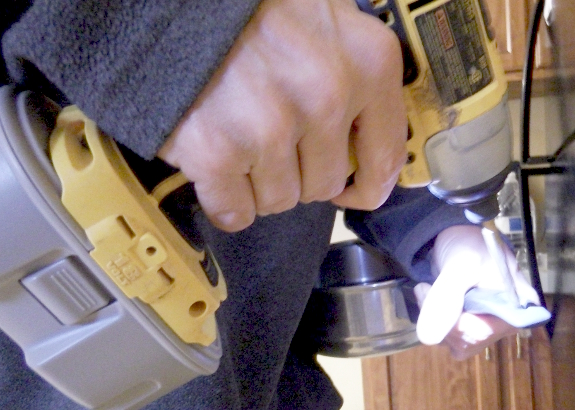
Back in Virginia, we hung our pots on
mug hooks. But
screws are easier to use high up on the wall in our new location. A
little bit of drilling ensured that each handle would slide easily over
the screw heads.
Anna was a little dubious
when I told her I could fit this oversized chair in the car.
The Goodwill people are very
nice and let us determine if it could fit in the trunk before we bought
it.
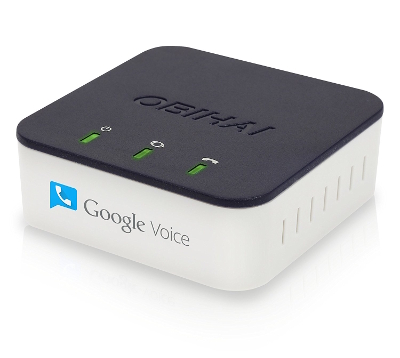 Since we had to set up all of
our utilities from scratch on our new property, Mark decided to enter
the twenty-first century in the process. Why pay for both internet and
a home phone when you can use VOIP technology to get both for the same
price?
Since we had to set up all of
our utilities from scratch on our new property, Mark decided to enter
the twenty-first century in the process. Why pay for both internet and
a home phone when you can use VOIP technology to get both for the same
price?
To that end, we spent
fifty bucks on a phone adapter that lets us plug an
ordinary home phone into our router. Then Mark set up a free Google Voice account that provided a
local phone number and simulates having a home phone. We did opt to pay
$25 per year for optional 911 service, but otherwise calls are totally
free within the U.S. and Canada.
What's the catch? There
are only a few. First, you can only set up a Google Voice account if
you already possess another phone number --- we used our emergency,
pay-as-you-go cell phone for that purpose. Also, there's no caller ID
on the phone (although you can see the number on the internet) and
voice messages are emailed instead of showing up on your home answering
machine.
On the plus side, phone
quality seems to be quite a bit better than on a cell phone. And the
transcribed voice messages that come to your email inbox are a major
time saver if your callers have a tendency to ramble on. Overall, this
is a cheap and easy solution for home phone service if you already pay
for internet service, and I suspect it'll be plenty for our
low-phone-use household.
One of the obstacles to
installing the new mini-split system is torquing down the flare nuts to
meet the torque requirements.
It's important to have it
tight but not overtightened due to temperature extremes.
We decided to go with a Tekton
drive click torque wrench
that allows you to dial in the torque you need and listen for the click
that lets you know you've reached the target torque value.
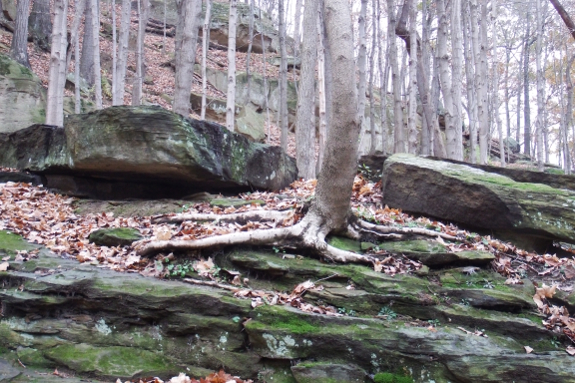
I tried out two new
trails this week, both closer to the city center than the ones I'd been
on previously. The first of these was Sells Nature Preserve, a
city-side add-on to Strouds 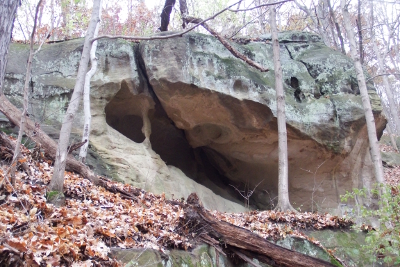 Run State Park. I'm afraid
this is the first Athens-area trail I can't wholeheartedly recommend.
The views of intricate rock formations were beautiful...but the road
noise of nearby East State Street was captured by the rocks so badly
that I felt I was walking through traffic.
Run State Park. I'm afraid
this is the first Athens-area trail I can't wholeheartedly recommend.
The views of intricate rock formations were beautiful...but the road
noise of nearby East State Street was captured by the rocks so badly
that I felt I was walking through traffic.
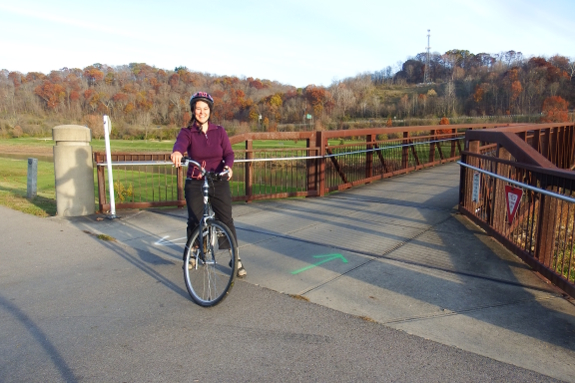
On the other hand,
biking down the Hockhocking Adena Bikeway was quite a treat! Our local
library is located on the path and lets you check out bikes and helmets
for free with your library card. Mark and I took advantage of the
opportunity and expect to do it again soon!
We chose the optional wall mount bracket to keep our
Mini split off the ground.
It is solid with heavy duty rubber feet and holes to attach them.
The reviews show how it's not designed for the normal 16 inch stud
spacing.
We worked around this by mounting some treated 2x4's to correct that
flaw.
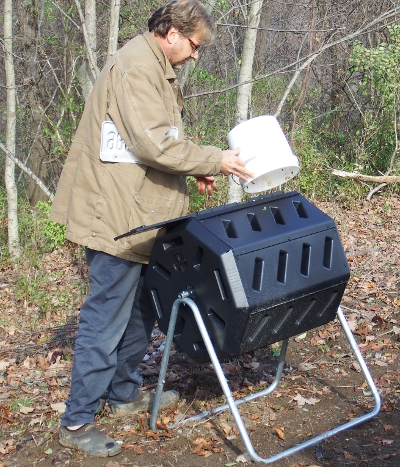 Since we were starting
entirely from scratch with cold weather nipping at our toes, Mark and I
made a few time-saving but money-spending decisions. One was a compost
tumbler, currently
$83 on Amazon --- a pretty good buy with a few minor downsides.
Since we were starting
entirely from scratch with cold weather nipping at our toes, Mark and I
made a few time-saving but money-spending decisions. One was a compost
tumbler, currently
$83 on Amazon --- a pretty good buy with a few minor downsides.Downside one is mentioned in the reviews --- the model is a bit tedious and fiddly to put together. I think it might have taken me an hour or two to assemble the tumbler with hand tools back before we had electricity. Of course, that was working entirely on my own, and I'm quite a bit less handy than Mark. Together (with the help of a battery powered driver), we likely could have put it together in thirty minutes flat.
Downside two is the size --- the unit feels smaller than it looks on the internet, and Mark (the main compost dumper) says it can be a bit tricky to fit scraps through the door without spilling any. That said, the interior is bigger than it looks --- I think we spent over a month filling up the first bin despite cold weather slowing decomposition. We're still hard at work filling bin two.
Which brings me to the major advantage of this model --- the tumbler is separated into two chambers. This is a major plus since you can fill one side then let it cook down as you fill the other. I'll keep you posted as our first round of Ohio-grown compost bakes!
You'll need a 1/2 inch deep socket to secure the anti-vibration feet to the mini split wall mount bracket.
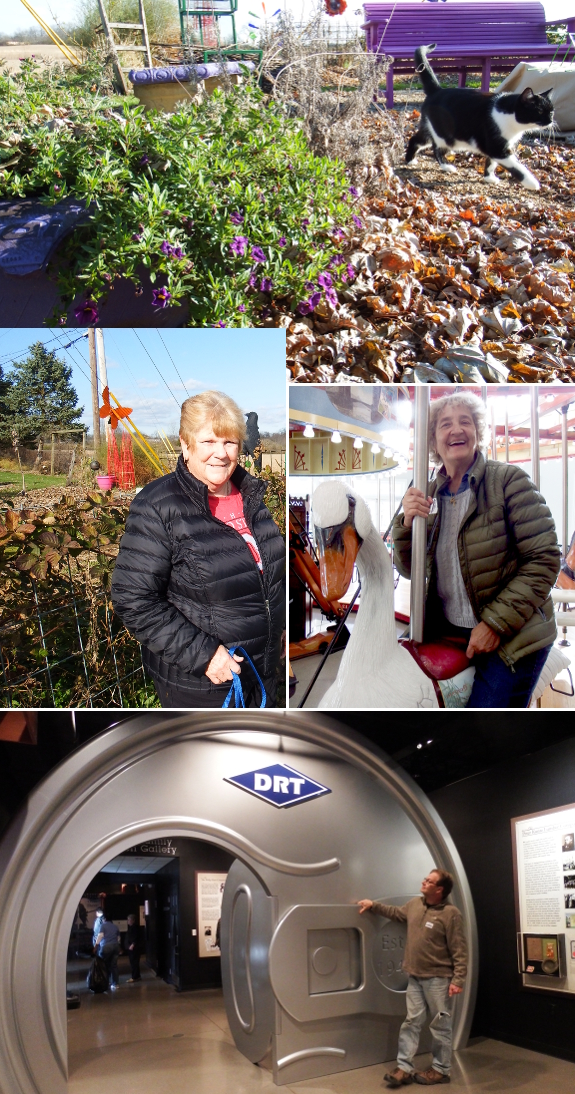
We celebrated Black
Friday with Rose Nell and Jayne. Between the excellent food, the fun
garden tour, and an extensive visit to Carillon Historical Park, Mark
and I came home refreshed and inspired. We'll obviously have to do it
all again soon!
We got this small greenhouse
kit to extend our leafy green season.
Thanks Mom for thinking of us
when you found it on clearance.
It only took us about 20
minutes to set it up and attach the roof and walls.
Next step is to secure it to the ground so it won't blow away during
windy days.
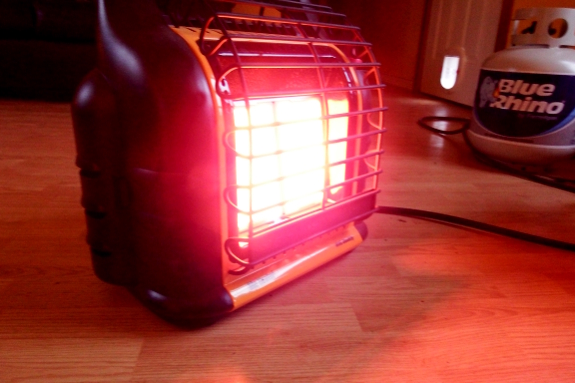
Back before our
electricity was hooked up, a cold spell hit and Mark and I got
desperate. "I'm so cold!" I whined as I tried to wash vegetables with
frozen fingers. "Get in the car," Mark replied.
We turned on the
heat...then headed straight to Lowes to check out the propane heater
options. Only one was labeled as safe for indoor use --- Mr.
Buddy, which is made
to run on little one-pound cylinders but can be easily converted over
to the larger canisters that are swappable at various stores in town.
On high, you get about an hour of heat per pound of propane...which is
a serious amount of warmth that can quickly heat up a large room. On
low, we kept our living space moderately warm for a week on a
fifteen-pound canister.
Although Mr. Buddy sits
solidly in the column of "desperation = money spent," the heater will
be a good backup during power outages (which I hear are just as serious
here as they were back in Virginia). Of course, we still plan to hook
up our wood stove as well, but it never hurts to have extra
redundancies for necessities as important as winter heat.
After we got the DuctlessAire
Mini
Split
heat pump wall mount bracket installed we realized it was
going to be too high for us to lift the main unit up onto.
We lowered it to the height
of our freezer so we could use it as a landing surface.
Want more in-depth information? Browse through our books.
Or explore more posts by date or by subject.
About us: Anna Hess and Mark Hamilton spent over a decade living self-sufficiently in the mountains of Virginia before moving north to start over from scratch in the foothills of Ohio. They've experimented with permaculture, no-till gardening, trailersteading, home-based microbusinesses and much more, writing about their adventures in both blogs and books.
